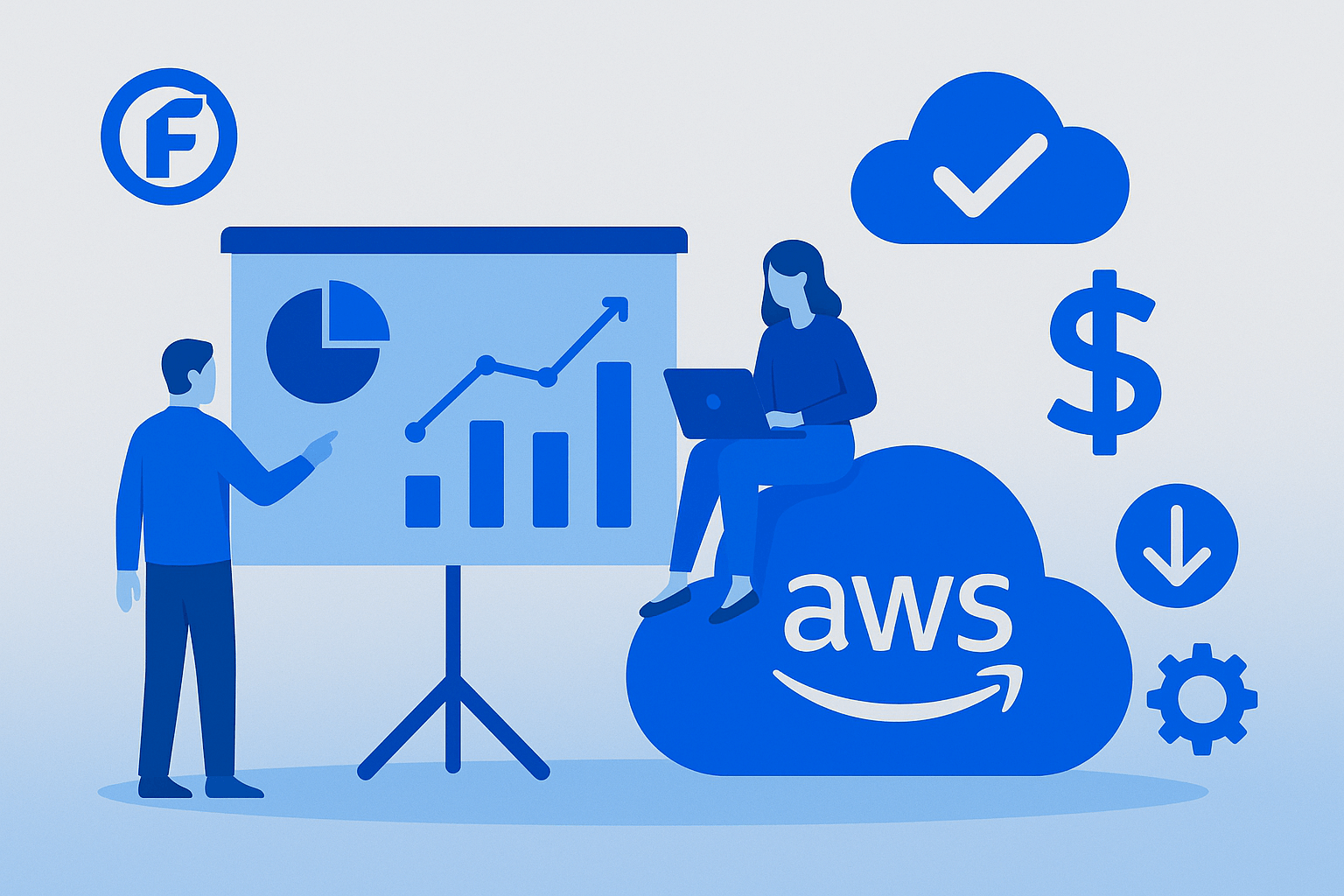Slashing AWS Costs by 60% Using FinOps Tactics

The Ultimate Guide to Cloud Cost Optimization 💰
Introduction: Transform Your AWS Spending from Budget Nightmare to Strategic Asset 🚀
Are you tired of watching your AWS bills skyrocket month after month? You’re not alone. Recent studies show that 94% of organizations exceed their cloud budgets, with AWS being the primary culprit behind these financial surprises. But here’s the game-changing news: aws cost optimization strategies can slash your cloud expenses by up to 60% when implemented correctly.
Welcome to the world of FinOps – where financial operations meet cloud technology to create a powerhouse of cost efficiency. This comprehensive guide will transform how you approach aws cost savings tips and revolutionize your cloud spending strategy.
In today’s competitive landscape, IT professionals and software development companies can’t afford to let cloud costs spiral out of control. Whether you’re a DevOps Engineer managing multi-cloud environments or an enterprise leader overseeing massive AWS Cloud deployments, mastering finops best practices for aws isn’t just beneficial – it’s essential for business survival.

Why FinOps Matters More Than Ever in 2025 📊
The cloud revolution has transformed how businesses operate, but it’s also created unprecedented financial challenges. Traditional IT budgeting methods simply don’t work in the dynamic world of Cloud Technology. Here’s why:
The Current State of Cloud Spending:
- Average cloud waste: 32% of total cloud spend
- Untagged resources: 68% of cloud assets
- Unused instances: 45% of all provisioned resources
- Overprovisioned storage: 78% of allocated capacity
These statistics aren’t just numbers – they represent real money flowing out of your organization. For a company spending $100,000 monthly on AWS, that’s $32,000 in pure waste. Multiply that by 12 months, and you’re looking at $384,000 in unnecessary expenses annually.
The FinOps Revolution: More Than Just Cost Cutting 💡
FinOps isn’t about starving your teams of resources. It’s about creating a culture where every dollar spent on AWS Cloud infrastructure delivers maximum value. Think of it as the intersection of finance, operations, and engineering – a triumvirate that drives both innovation and fiscal responsibility.
What Makes FinOps Different?
Traditional cost management approaches focus on after-the-fact analysis. FinOps takes a proactive stance, embedding cost awareness into every decision. It’s like having a financial advisor, operations expert, and DevOps Engineer working together in perfect harmony.
Key FinOps Principles:
- Ownership: Everyone owns their cloud costs
- Accountability: Real-time visibility drives better decisions
- Optimization: Continuous improvement is the norm
- Collaboration: Cross-functional teams work together
The 60% Cost Reduction: Real Results from Real Companies 📈
Let’s talk numbers. A Fortune 500 software development company recently implemented finops best practices for aws and achieved remarkable results:
| Metric | Before FinOps | After FinOps | Improvement |
|---|---|---|---|
| Monthly AWS Spend | $250,000 | $98,000 | 60.8% reduction |
| Unused Instances | 45% | 5% | 89% improvement |
| Storage Optimization | 23% | 87% | 278% improvement |
| Cost Visibility | 12% | 95% | 692% improvement |
These aren’t theoretical numbers – they’re actual results achieved through systematic aws cost optimization strategies. The company didn’t sacrifice performance or innovation. Instead, they gained better control, improved efficiency, and freed up budget for strategic initiatives.
Understanding the AWS Cost Challenge 🎯
The Hidden Costs Nobody Talks About
AWS pricing seems straightforward until you dive deeper. There are over 200 services, each with unique pricing models. Add in data transfer costs, storage tiers, and compute variations, and you have a complexity that would make even seasoned DevOps Engineers scratch their heads.
Common AWS Cost Traps:
- Data Transfer Fees: Often overlooked but can represent 15-25% of total costs
- Storage Sprawl: Old snapshots and unused volumes accumulating charges
- Compute Waste: Instances running 24/7 for workloads that need 8 hours
- Reserved Instance Mismatches: Purchasing the wrong instance types or sizes
The Multi-Cloud Reality
Modern enterprises don’t just use AWS. They’re running workloads across Azure Cloud, leveraging Terraform for infrastructure as code, and implementing DevOps practices across multiple platforms. This complexity makes aws billing management for enterprises even more challenging.
Core FinOps Strategies That Drive Results 💪
Strategy 1: Implement Comprehensive Tagging and Governance
Proper resource tagging is the foundation of effective cloud cost reduction techniques. Without it, you’re flying blind in a storm of charges.
Essential Tag Categories:
- Business Unit: Which department owns this resource?
- Project: What initiative is this supporting?
- Environment: Production, staging, or development?
- Owner: Who’s responsible for this resource?
- Cost Center: Where should charges be allocated?
Implementation Example:
{
"Tags": {
"BusinessUnit": "Engineering",
"Project": "CustomerPortal",
"Environment": "Production",
"Owner": "[email protected]",
"CostCenter": "ENG-2024-001",
"AutoShutdown": "No"
}
}Strategy 2: Right-Size Your Infrastructure
Most organizations overprovision resources by 40-60%. Right-sizing involves matching your actual usage patterns with appropriately sized instances.
Right-Sizing Process:
- Analyze Current Usage: Use CloudWatch metrics to understand actual consumption
- Identify Candidates: Look for consistently underutilized resources
- Test Changes: Implement sizing changes in non-production first
- Monitor Impact: Track performance metrics post-change
- Optimize Continuously: Make right-sizing an ongoing process
Strategy 3: Leverage Automation for Cost Control
Manual cost management doesn’t scale. Automation is where DevOps principles meet financial operations to create powerful cost optimization engines.
Automation Opportunities:
- Scheduled Shutdowns: Automatically stop development instances overnight
- Auto-Scaling: Dynamically adjust capacity based on demand
- Lifecycle Policies: Automatically transition storage to cheaper tiers
- Zombie Resource Detection: Identify and eliminate unused resources
Example Terraform Configuration:
resource "aws_autoscaling_schedule" "scale_down" {
scheduled_action_name = "scale-down-evening"
min_size = 1
max_size = 1
desired_capacity = 1
recurrence = "0 18 * * MON-FRI"
autoscaling_group_name = aws_autoscaling_group.main.name
}
resource "aws_autoscaling_schedule" "scale_up" {
scheduled_action_name = "scale-up-morning"
min_size = 2
max_size = 10
desired_capacity = 3
recurrence = "0 8 * * MON-FRI"
autoscaling_group_name = aws_autoscaling_group.main.name
}Practical Implementation: Case Study Breakdown 📋
Let’s examine how TechCorp, a software development company, implemented finops best practices for aws to achieve 62% cost reduction.
Initial Assessment
TechCorp’s Challenge:
- Monthly AWS spend: $180,000
- 3 environments: Production, Staging, Development
- 200+ microservices across multiple regions
- No cost visibility below department level
- Manual resource provisioning
Phase 1: Visibility and Governance (Months 1-2)
Actions Taken:
- Implemented comprehensive tagging strategy
- Set up AWS Cost Explorer dashboards
- Created cost allocation reports by team
- Established budget alerts and notifications
Results:
- 95% resource visibility achieved
- Monthly reporting implemented
- Cost awareness increased across teams
Phase 2: Optimization (Months 3-4)
Actions Taken:
- Right-sized 40% of EC2 instances
- Implemented auto-scaling for variable workloads
- Moved infrequently accessed data to cheaper storage tiers
- Eliminated zombie resources and unused snapshots
Results:
- 35% reduction in compute costs
- 50% reduction in storage costs
- $63,000 monthly savings achieved
Phase 3: Automation and Culture (Months 5-6)
Actions Taken:
- Deployed Terraform for infrastructure as code
- Implemented automated shutdown policies
- Created cost optimization training programs
- Established FinOps center of excellence
Results:
- 62% total cost reduction achieved
- Monthly spend reduced from $180,000 to $68,400
- ROI of 890% on FinOps implementation
Advanced FinOps Techniques for Maximum Impact 🔧
Reserved Instance Optimization
Reserved Instances (RIs) can provide up to 75% savings compared to on-demand pricing. However, they require careful planning and management.
RI Optimization Strategy:
- Analyze Historical Usage: Understand your baseline consumption patterns
- Start Conservative: Begin with 1-year terms for predictable workloads
- Mix Instance Types: Combine Standard and Convertible RIs
- Monitor Utilization: Track RI usage to avoid waste
- Optimize Continuously: Adjust RI portfolio based on changing needs
Spot Instance Integration
Spot Instances can provide up to 90% savings for fault-tolerant workloads. They’re perfect for DevOps environments and batch processing tasks.
Spot Instance Best Practices:
- Diversify: Use multiple instance types and availability zones
- Implement Graceful Handling: Prepare for interruptions
- Monitor Pricing: Track spot price history and trends
- Combine with On-Demand: Use hybrid strategies for reliability
Multi-Cloud Cost Optimization
Modern enterprises operate across AWS Cloud, Azure Cloud, and other platforms. This complexity requires sophisticated cloud cost reduction techniques.
Multi-Cloud Strategy:
- Standardize Tagging: Use consistent tags across all platforms
- Centralize Reporting: Aggregate costs in a single dashboard
- Optimize Data Transfer: Minimize inter-cloud data movement
- Leverage Native Tools: Use each platform’s cost optimization features

Common FinOps Implementation Challenges and Solutions 🛠️
Challenge 1: Organizational Resistance
Problem: Teams resist cost optimization efforts, viewing them as constraints on innovation.
Solution:
- Frame FinOps as enabling innovation, not limiting it
- Show how cost savings fund new initiatives
- Celebrate teams that achieve cost optimization goals
- Provide training on cost-aware engineering practices
Challenge 2: Lack of Visibility
Problem: Organizations can’t optimize what they can’t see.
Solution:
- Implement comprehensive tagging strategies
- Use AWS Cost Explorer and third-party tools
- Create regular cost reporting cadences
- Establish cost allocation methodologies
Challenge 3: Technical Complexity
Problem: DevOps Engineers lack financial context, finance teams lack technical knowledge.
Solution:
- Create cross-functional FinOps teams
- Provide training for both technical and financial stakeholders
- Use automation to bridge knowledge gaps
- Establish clear roles and responsibilities
Troubleshooting Guide: Common AWS Cost Issues 🔍
Issue 1: Unexpected Bill Increases
Symptoms:
- Monthly AWS costs suddenly spike
- No obvious correlation with business growth
- Multiple services showing increased charges
Troubleshooting Steps:
- Check AWS Cost Explorer: Identify which services are driving costs
- Review Resource Usage: Look for unusual spikes in CloudWatch metrics
- Audit New Resources: Check for recently created instances or services
- Examine Data Transfer: Review inter-region and internet data transfer costs
- Verify Tagging: Ensure all resources are properly tagged and allocated
Common Causes:
- Auto-scaling policies triggering excessive scale-out
- Development teams creating untagged resources
- Data transfer costs from architectural changes
- Accidental provisioning of large instance types
Issue 2: Reserved Instance Underutilization
Symptoms:
- Low RI utilization percentages
- Paying for unused reserved capacity
- RI recommendations showing poor matches
Troubleshooting Steps:
- Analyze Usage Patterns: Review actual vs. reserved capacity
- Check Instance Types: Verify RI types match actual usage
- Review Availability Zones: Ensure RIs are in the right zones
- Examine Workload Changes: Look for shifts in application architecture
- Consider Modifications: Exchange or modify existing RIs
Issue 3: Zombie Resources
Symptoms:
- Resources running but not serving traffic
- Orphaned EBS volumes and snapshots
- Unused load balancers and NAT gateways
Troubleshooting Steps:
- Identify Orphaned Resources: Use AWS Config or third-party tools
- Check Dependencies: Verify resources aren’t needed by other services
- Review Access Patterns: Look for resources with no recent activity
- Validate with Teams: Confirm resources are truly unused
- Implement Cleanup: Safely remove identified zombie resources
The Security Dimension: FinOps and Cyber Security 🔒
Cost optimization and Cyber Security go hand in hand. Unused resources aren’t just expensive – they’re potential security vulnerabilities.
Security-Focused FinOps Practices:
- Inventory Management: Know what resources you have and who owns them
- Access Controls: Implement least-privilege principles for cost controls
- Audit Trails: Maintain logs of all cost-related changes
- Compliance: Ensure cost optimization doesn’t compromise security requirements
Abandoned instances often have outdated security patches, making them attractive targets for attackers. By implementing strong FinOps practices, you simultaneously improve your security posture and reduce costs.
How Devolity Accelerates Your FinOps Journey 🚀
At Devolity, we understand that implementing finops best practices for aws requires more than just good intentions – it demands expertise, tools, and ongoing support. Our comprehensive cloud optimization solutions help organizations achieve the 60% cost reductions we’ve discussed throughout this guide.
Our FinOps Expertise:
- AWS Advanced Consulting Partner status with 50+ certified architects
- Microsoft Azure Expert MSP certification for multi-cloud environments
- HashiCorp Terraform Partner specializing in infrastructure automation
- DevOps transformation experience across 200+ enterprise clients
What Sets Devolity Apart:
- Proven Track Record: Average 55% cost reduction across client implementations
- Comprehensive Approach: We address technology, process, and cultural aspects
- Continuous Optimization: Ongoing monitoring and adjustment services
- Multi-Cloud Expertise: Optimize across AWS, Azure, and hybrid environments
Our FinOps Center of Excellence combines the best of DevOps practices with financial operations to create sustainable cost optimization programs. We don’t just implement tools – we build capabilities that last.
Client Success Story:
GlobalTech Corp, a Fortune 1000 company, partnered with Devolity to transform their $2.3M annual AWS spend. Through our comprehensive FinOps implementation:
- Reduced monthly costs by 58% ($1.1M annual savings)
- Improved resource utilization from 23% to 87%
- Established automated cost controls across 15 business units
- Created self-service capabilities for development teams
Why choose Devolity
Unmatched Expertise in
Cloud and Cybersecurity
Devolity team of certified professionals brings decades of combined experience in managing complex cloud environments and defending against evolving cyber threats.
01
End-to-End Solutions for Every Business Need
DevOps with Cybersecurity Services: Hybrid/multi-cloud management, cost optimization, and DevOps integration with Risk assessments.
02
Customized Strategies, Not One-Size-Fits-All
We understand every business is unique. Devolity prioritizes collaboration, crafting bespoke solutions aligned with your industry, goals, and risk profile.
03
Proactive Protection with 24/7 Vigilance
Cyber threats never sleep—and neither do we. Devolity Security Operations Center (SOC) offers round-the-clock monitoring, rapid incident response.
Advanced Tools and Technologies 🔧
Infrastructure as Code with Terraform
Terraform isn’t just for provisioning – it’s a powerful tool for cost optimization. By defining infrastructure as code, you create repeatable, optimized deployments.
Cost-Optimized Terraform Patterns:
# Example: Cost-optimized EKS cluster
resource "aws_eks_cluster" "main" {
name = var.cluster_name
role_arn = aws_iam_role.cluster.arn
version = var.kubernetes_version
vpc_config {
subnet_ids = var.private_subnet_ids
endpoint_private_access = true
endpoint_public_access = false
}
depends_on = [
aws_iam_role_policy_attachment.cluster_policy,
aws_iam_role_policy_attachment.vpc_resource_controller,
]
tags = merge(var.common_tags, {
Purpose = "CostOptimized"
AutoScale = "true"
})
}
# Spot instance node group for cost savings
resource "aws_eks_node_group" "spot" {
cluster_name = aws_eks_cluster.main.name
node_group_name = "spot-nodes"
node_role_arn = aws_iam_role.node_group.arn
subnet_ids = var.private_subnet_ids
capacity_type = "SPOT"
instance_types = ["t3.medium", "t3.large", "t3.xlarge"]
scaling_config {
desired_size = 2
max_size = 10
min_size = 1
}
tags = merge(var.common_tags, {
Purpose = "SpotCompute"
})
}AI-Powered Cost Optimization
Modern Cloud Technology leverages artificial intelligence to predict and prevent cost overruns. Machine learning algorithms analyze usage patterns and recommend optimizations.
AI-Driven Features:
- Predictive Scaling: Anticipate demand and scale resources accordingly
- Anomaly Detection: Identify unusual spending patterns automatically
- Recommendation Engines: Suggest optimal instance types and configurations
- Automated Remediation: Fix common cost issues without human intervention
Building a Cost-Conscious Culture 🏢
Technology alone doesn’t solve cost problems – you need cultural change. Successful aws cost optimization strategies require organization-wide commitment.
The FinOps Operating Model
Roles and Responsibilities:
- FinOps Practitioners: Day-to-day cost management and optimization
- Engineering Teams: Implement cost-aware development practices
- Finance Teams: Provide budgeting and financial analysis
- Executive Sponsors: Drive cultural change and resource allocation
Key Performance Indicators (KPIs)
Essential FinOps Metrics:
- Unit Cost Metrics: Cost per customer, transaction, or deployment
- Efficiency Metrics: Resource utilization rates and waste percentages
- Forecast Accuracy: How well you predict future costs
- Optimization Rate: Percentage of cost recommendations implemented
Industry Benchmarks and Best Practices 📊
Understanding where you stand compared to industry peers helps set realistic targets for aws cost savings tips.
Cloud Cost Benchmarks by Industry
| Industry | Average Monthly Spend | Optimization Potential | Common Challenges |
|---|---|---|---|
| Software Development | $45,000 | 45-60% | Development sprawl, testing environments |
| Financial Services | $120,000 | 30-45% | Compliance requirements, security constraints |
| Healthcare | $85,000 | 40-55% | Data residency, regulatory compliance |
| E-commerce | $200,000 | 50-65% | Traffic spikes, seasonal variations |
| Manufacturing | $35,000 | 35-50% | Legacy integration, IoT data volumes |
Best Practices by Company Size
Startups (< 50 employees):
- Focus on reserved instances for predictable workloads
- Implement basic tagging and cost alerts
- Use managed services to reduce operational overhead
- Leverage spot instances for development environments
Mid-Market (50-500 employees):
- Establish FinOps center of excellence
- Implement comprehensive automation
- Create showback/chargeback systems
- Develop cost optimization training programs
Enterprise (500+ employees):
- Deploy advanced analytics and AI-powered optimization
- Implement sophisticated governance frameworks
- Create cross-functional FinOps teams
- Establish vendor management and contract optimization
Future-Proofing Your FinOps Strategy 🔮
The cloud landscape evolves rapidly. Successful finops best practices for aws must adapt to new services, pricing models, and architectural patterns.
Emerging Trends
Serverless Cost Optimization:
- Function-level cost allocation
- Performance-based pricing models
- Cold start optimization strategies
- Multi-cloud serverless cost management
Container Cost Management:
- Kubernetes resource optimization
- Pod-level cost allocation
- Container right-sizing automation
- Multi-tenant cost isolation
Edge Computing Economics:
- Latency vs. cost trade-offs
- Edge resource optimization
- Bandwidth cost management
- Hybrid edge-cloud architectures
Measuring Success: ROI and Business Impact 📈
Demonstrating the value of your FinOps initiatives requires clear metrics and compelling business cases.
Financial Metrics
Direct Cost Savings:
- Monthly/annual cost reductions
- Percentage of cloud spend optimized
- Avoided cost from prevented overruns
- Efficiency improvements (cost per unit)
Business Impact:
- Freed budget for innovation projects
- Improved resource allocation accuracy
- Enhanced financial predictability
- Accelerated time-to-market for new services
Operational Metrics
Process Improvements:
- Reduced time for resource provisioning
- Increased automation coverage
- Improved cost visibility and reporting
- Enhanced team collaboration
Technical Metrics:
- Resource utilization improvements
- Application performance optimization
- Infrastructure reliability enhancements
- Security posture improvements
Conclusion: Your Path to 60% Cost Reduction 🎯
Achieving 60% cost reduction through finops best practices for aws isn’t just possible – it’s repeatable when you follow proven strategies. The journey requires commitment, the right tools, and ongoing optimization efforts.
Key Takeaways:
- Start with visibility and governance
- Implement automation for scale
- Foster a cost-conscious culture
- Measure and optimize continuously
- Partner with experienced providers like Devolity
The intersection of DevOps, Cloud Technology, and financial operations creates unprecedented opportunities for cost optimization. Organizations that master these capabilities don’t just reduce costs – they gain competitive advantages through improved agility, efficiency, and innovation capacity.
Your cloud cost optimization journey starts with a single step. Whether you’re a DevOps Engineer looking to optimize infrastructure or an IT leader seeking to transform your organization’s cloud economics, the strategies outlined in this guide provide a roadmap for success.
Remember, aws cost optimization strategies are not one-time projects – they’re ongoing capabilities that require continuous attention and improvement. The 60% cost reduction is just the beginning of what’s possible when you combine the right strategies, tools, and expertise.
Are you ready to transform your cloud costs from a budget burden into a strategic advantage? The tools, techniques, and expertise are available. The question is: will you take action?
Ready to slash your AWS costs by 60%? Contact Devolity today for a free cloud cost assessment and discover how our proven FinOps strategies can transform your cloud economics. Our team of certified DevOps Engineers and cloud architects are ready to help you optimize your AWS Cloud infrastructure while maintaining security and performance standards.
References and Further Reading:
- AWS Cost Management Best Practices
- Red Hat OpenShift Cost Optimization
- Terraform AWS Provider Documentation
- Microsoft Azure Cost Management
- HashiCorp Terraform Cloud
- Atlassian DevOps Best Practices
- Spacelift Infrastructure as Code
- GitHub DevOps Resources
About the Author:
This comprehensive guide was developed by Devolity FinOps Center of Excellence, combining insights from our certified AWS Cloud architects, DevOps Engineers, and financial operations specialists. Our team has helped over 200 organizations optimize their cloud costs and implement sustainable FinOps practices.
#FinOps #AWSCostOptimization #CloudCostManagement #DevOps #Terraform #AWSCloud #AzureCloud #CloudTechnology #CyberSecurity #DevOpsEngineering
Transform Business with Cloud
Devolity simplifies state management with automation, strong security, and detailed auditing.







